
If you don’t think yoga is a feminist issue try suggesting as author and feminist historian Vicki Noble does, that women invented the ancient practice. Noble’s assertion defies the common myth that women were not allowed to practice yoga until the past century. But as Tantric scholar Ramesh Bjonnes writes “women have been gurus, healers, yoginis, and Goddesses since the beginning of time”.
Today the majority of yoga practitioners are women. While fair access to downward dog might seem on the surface like a feminist victory, Noble and other feminist researchers tell a very different story. They ask – why are women still practicing a form of yoga developed by men – only for men? In fact, their research is uncovering evidence of an alternative, much more ancient female centered yoga practice that preceded the Vedic yogis by thousands of years.
Who knew?
Noble’s research into what she called the “female blood roots” of yoga suggests there was a widespread female-centered communal yoga practice dating from the upper Paleolithic and Neolithic. Celebrating the natural powers of “bleeding, birthing, healing and dying”, this early yoga was practiced in rituals of trance and dance. In this way disease was believed to be purged from the community and fertility in women, animals, and food crops enhanced.
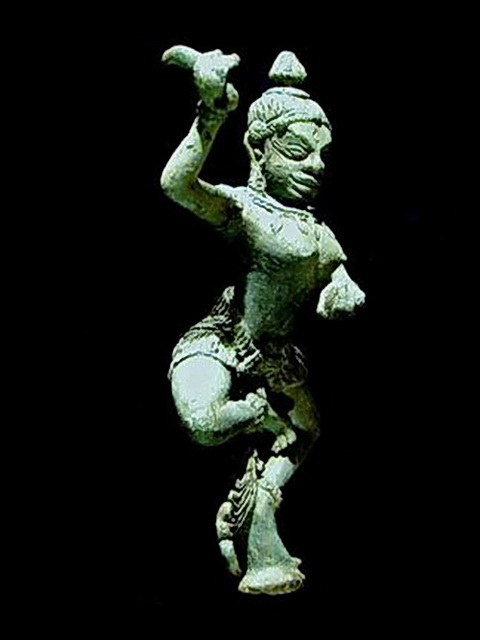
Noble points to the images of female Buddha’s and high-ranking shaman priestesses which are so pervasive in the artifacts and figurines of Old Europe and Asia(6000 BCE). She proposes that the varied poses shown in these early sculptures, as well as frescoes, murals, and rock art through the ages, are expressions of an ancient shamanistic yoga eventually codified into the formal schools we know today.

Noble believes these cross-cultural sculptures, seals and figurines depict women in body postures startlingly similar to yoga asana. Many show women seated with eyes closed, legs crossed over one another or standing feet together with arms raised. Some wear waist necklaces and beaded hip-belt over their pubic area, resembling later images of Indian Yoginis or Tibetan Dakinis. Noble writes “although such figures predate the formal codification of yoga in India by many thousands of years, each of them could be said to graphically depict steps of yoga that lead to “progressively deeper levels of awareness and functioning until, finally, ordinary consciousness is transcended in the bliss of ecstasy.”
Monica Sjoo is another feminist historian who has written extensively about the history of women’s yoga. Sjoo claims that the concept of raising Kundalini energy, so fundamental to yoga philosophy and practice, originated with these yogic priestesses. She points out that many prehistoric figurines show women merged with tree’s, with snakes coiling around their bodies, and emerging from their heads. Were these women raising the serpentine energy (kundalini) up the world tree ( human spine) to achieve ‘wings’ or illuminated consciousness (enlightenment)?
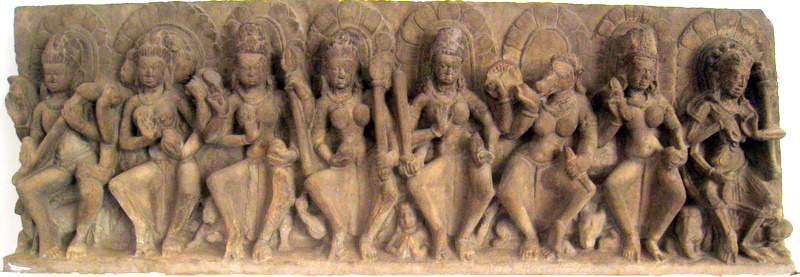
Both Sjoo and Noble argue that the concept of Kundalini originated in the female “Siddhis” (yogic powers) of menstruation, female sexuality, natural birth, and menopause. Noble believes these ancient yogic rites encouraged the free, spontaneous flow of kundalini energy through the female group, and by extension, throughout the entire community.
Today yoga scholars generally agree that the discovery of a seal in the Indus Valley (depicting a man seated in what we would now refer to as Lotus posture) is the first historical reference to yoga. But there are many similar seals and figurines depicting women in ritual body postures – and many of them much older. As Uma Dinsmore-Tuli writes in her book Yoga Shakti: A Guide to Women’s to Power and Freedom Through Yoga and Tantra “ ”The fact that most of the figurines unearthed in the Indus Valley were female is the Indian link from the matriarchal Paleolithic civilizations to the prehistory of yoga.”
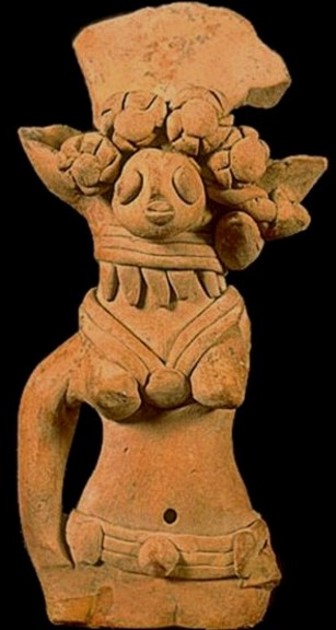
Modern yoga is acknowledged to be largely derived from the Hatha tradition, but the roots of Hatha reach further to Tantra. Scholar Ramesh Bjonnes writes” …if we talk about yoga as practice, as spiritual technology, its source is ancient, prehistoric Tantra, not the Vedas… it seems compelling that yoga emerged from Shamanism rather than from the priestly Vedic tradition, as most Western yoga scholars believe.” And ancient prehistoric Tantra dates back to the female centered shamanic practices of prehistory.
Miranda Shaw is a historian on the female roots of Tantra Yoga. In her book Passionate Enlightenment she describes the remains of round, open-air stone temples still found in India where animal-headed statues of dancing women, stand as a reminder of these yogini’s ecstatic rites.
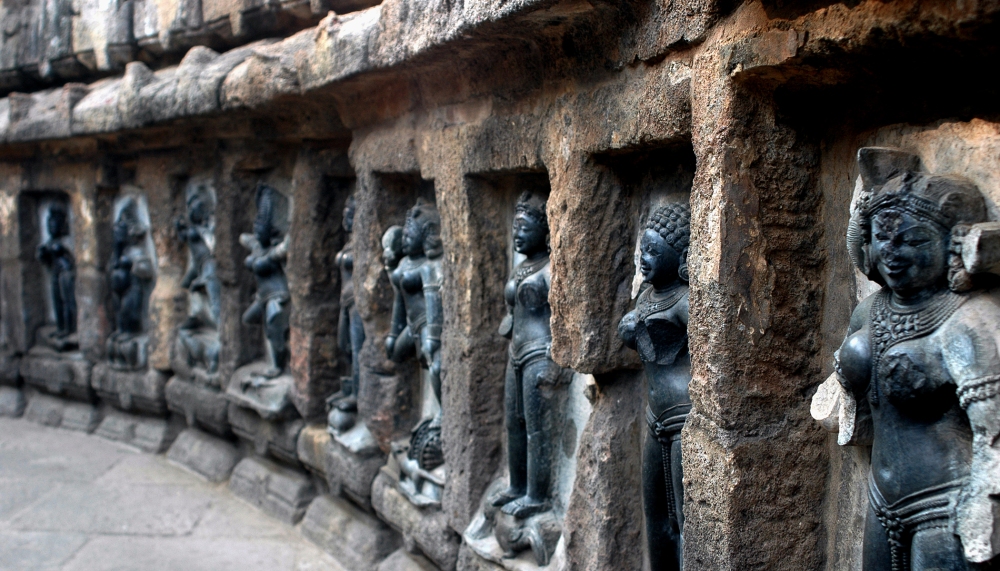
Shaw writes how yogini’s gathered at feasts to play “cymbals, bells, and tambourines and danced within a halo of light and a cloud of incense.” Within this nocturnal congregation, “a circle of yoginis feasted, performed rituals, taught, and inspired one another”. They sang “songs of realization” regaling one another “with spontaneous songs of deep spiritual insight.”

The magical potency of Tantra was transmitted by a female line “power-holders” – a mysterious sect of women called the Vratyas – and they were not an isolated case. Taoist Yoginis from China and Dakinis from Tibet were also powerful spiritual teachers, giving empowerments and initiations.
Female Tantrics were called by many names, Dakinis (woman who flies) Vidyadharim (knowledge-holder) Vira (heroine) but the most common term was Yogini (keeper of the occult secrets). So who were these women – and why do we know so little of their history today?
Noble, Shaw and Sjoo agree that with the advance of patriarchy, the ecstatic techniques of women were gradually swallowed up by the more ascetic practices of men. In seated meditation, the transcendent was sought not through the body, but through the practices of mind. Women and their biological functions came to be negatively equated with the life of the body and soon female rites were outlawed altogether. Yogini’s and dakini’s became “witches,” “ogresses,” “demonesses,” or “temple harlots”.

But their teachings, as Sjoo and Noble contend, were not extinguished – they were co–opted to become the new “secret” knowledge of a new spiritual elite, the Brahmin priesthood. And over time we forgot there was once a different kind of yoga. One in which the inherent powers of the female body were celebrated and harnessed for illumination, freedom and compassion – and the benefit of community.
Noble believes yoga is a feminist issue because until we understand women’s central role in the development of yoga, it cannot be a truly effective female practice. Noble teaches what she calls Lunar Yoga, a yoga tuned to the ancient lunar calendar and the natural cycles of women. Here the focus is not on perfecting yogic postures but on experiencing energy “flow”. She urges women to reclaim the “natural, biological ways of accessing and experiencing the yogic power of our ancient fore-sisters”.
Noble writes although the idea of woman’s yoga ” might appear to glorify the female at the expense of the male, or capitulate to a worn-out 1950’s idea that “biology is destiny,” it actually does neither.” Instead it seeks to acknowledge the “dynamic quality of ecstasy that especially seems to mark the female-centered yoga experience.” It seems Noble’s call is being heard. More and more we reject a view of the body as defiled, coming into alignment with an ancient feminine view of the body as sacred, a vessel for the divine.
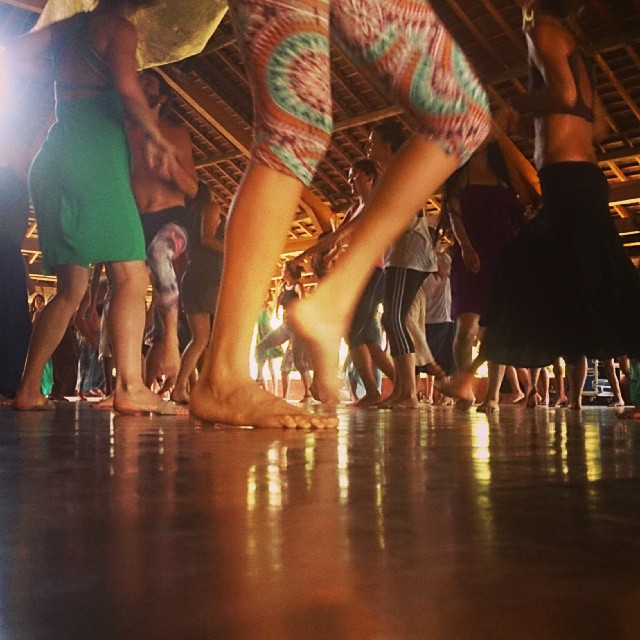
So as we gather in communal classes, I wonder if our practice of yoga can become, like the practices of our ancient ancestors, a ritual of blessing and healing within the community? According to Noble, the legacy of the ancient yoginis can be “activated in the here-and-now to bring balance and renewal to our community through our delight in the powers of the physical body.”
To me this seems like a yogic heritage well worth keeping. So I just don’t get why, despite the recent spate of articles and books exploring the historical roots of yoga, so few mention women’s contributions. Why is it that the current debate amongst yoga scholars regarding the true historicity of yoga (is it 5000 years old or just 500) barely takes into account the legacy of ancient yoginis? I find this blind spot puzzling. I can’t help but wonder, in this so-called post feminist era, if yoga really has “come a long way baby”?

Interesting article which I wholeheartedly agree with. It is clear that ancient Yoginis were a great part of the science of Yoga, and the corruption that unfortunately came to grip India has sought to repress their truth.
One thing I will point out, the Hatha Yoga Pradipika stresses the importance of purifying the physical body (in conjunction with the mind) as a pathway to soul realization. Iyengar also stresses this.
A provocative title; however, I doubt that women invented yoga any more than men did. ‘yoga trance dance’ is simply shamanic dancing with a new name, practiced around the world by all indigenous cultures in various fashions. However, it is very possible based on the prevalence of female terms in yoga – shakti and kundalini in particular – that in its early development there was far more gender equality in Indian society, and the many legends of the Indian Goddesses were likely simply Enlightened women who were later deified; (even as Christ and Buddha have been) — even as Amma is today.
I agree with you. and you might be interested in my blog about the subject: http://lindasyoga.blogspot.com/2010/05/yogini-cult-jai-ma.html
and I would have to agree with the above commenter about trance dance. Shiva Rea didn’t invent “trance dance” as people came out of the caves dancing. I am a long time Nia practitioner, which I think was before Shiva’s trance dance stuff.
Absolutely great post – really enjoyed that – lots to follow up on…thank you!
I think we can conclude that Shiva Rae didn’t ‘create trance dance’ but has certainly done a very good job in branding and marketing it as if she did just as so many people are doing with yoga. Whenever I say I practice yoga I get asked ‘oh what sort?’ because the branding has become more important than the practice it would seem.
how silly, nobody invented yoga. That’s like saying einstein invented relativity.
Love this article. The body is the body. All the rest is spin. Dancing, yoga, music, all of it is the collective stuff we bring to make sense of embodied life. In a world of marketing and spin and patents the whole thing gets warped. I have been teaching Nia for years too and I never forget that before there was a name for what I do, there was me being moved by the pleasure and ecstasy I feel when I move my body and especially when I dance to music…
Women did not invent yoga and neither did men. It’s a language of the body that flowers in each of us when the self is dissolved and an “other” energy has room to maneuver. Now, whether this “other” energy has its origins in, or the flavor of, a divine feminine is something worth exploring.
This article proofs that the western culture has fundamental problems understanding Indian religions.
This problem reaches far back.
A few facts:
Yoga does not mean stretching.
Stretching is a natural action to relax muscles, most mammals do it.
Women still do not practice Yoga, as New Age Buddhists do not practice Buddhism.
Carvings and statues in certain positions do not proof anything, artistic freedom is not a new invention.
The cultures of India were highly divergent for the last 500 years. There are no records what so ever about most of these cultures or their foreign influences. So pretty much nothing can traced back in the Indian history besides some common artifacts and architecture.
There is nothing wrong with promoting a sport, but please leave history out of it.
There is literature dating much further back than 500 years as well as temple carvings with various poses in Tantric use including sex positions, meditation positions and yoga positions all with a formulaic progress. Please visit the Sun Temple in Konark to see for yourself. The yogini temples are more than a thousand years old and you can still go visit them. Patanjali wrote the Yogas Sutras mentioning nothing of the physical and then later Hatha yoga poses and prescriptions were found in a Tantric text focusing primarily on the physical. So yes history does play a role here, so long as the research is done. An excellent resource is David Gordon White’s book “Kiss of the Yogini”. Further, Odissi Classical Indian Temple Dance is from the Devadasi who performed ritual dance in the temples and thus their dance was codified, sculpted, drawn and written about. It may certainly have been ecstatic but it was anything but free form. Here you will also find that the dance and yoga positions were performed by females as they were the physical embodiment of the goddess from which the king or godhead of the land drew his legitimacy. In general the female knowledge was held in the body while the male knowledge was held in the thought. This certainly doesn’t mean that men didn’t participate in physical forms or that women didn’t participate in philosophical exercises. But in ancient India per many Tantric texts and palm leaf scrolls of which you can find English translations, women were the primary holders of the physical arts, including what today we refer to as yoga as a physical practice.
Great article. I have always had an interest in this and Tai Chi, and have been reading and researching when I have time.
Reblogged this on An Lidia Thys.
Reblogged this on The Land of the Wu 巫.
What a wonderful, thought-provoking article that, as a long-time yoga practitioner and dance/movement enthusiast of all kinds, feels absolutely true in every fibre of my being. I see the amazing work of Gabrielle Roth and the Five Rhythms practice as another example of the ecstatic practices of ancient dance and the profound shamanic healing that can come through movement. I feel the ancient traces of female energy and the power of the goddess when I allow my body to dance in this way which makes me feel as though I have experienced firsthand some of the transcendent healing from the female energy described in this article. Thank you for bringing this history to light for us to consider, honor, and celebrate.
I agree- I am thankful to read post like this…
Well done. The space for the Sacred Feminine is too often dismissed, or re-appropriated, by spiritual traditions that claim to embrace them. It’s lovely to read this article and its linkage to the shamanic priestess tradition. It resonates 🙂
Blessings,
Priestess Bairavee Balasubramaniam PhD
Lots to process. Ultimately, yogic philosophy does state a women can only reach samadhi with a male teacher and/or lover. Unlike men, that must renounce in order to achieve enlightenment. This article has opened my mind up to the true balance hidden in this ancient art form. I’m less interested in who exactly hid this knowledge, than I am to learn and explore these higher possibles with myself. Thank you for sharing.
Thank you for your time energy and love in putting this article together. The sacred yoga of women was surely known and experienced in those ancient times. Whether or not it inspired the males in their practices which is hard to say for sure it was a potent healing force which would definetly have had a huge impact on their culture’s evoltion.
This article is important to consider for women who practice and men who teach as modern practices do not wholly support the cyclical nature of women’s cycles / seasons of life. Women experience life differently to men and most may not be suited to either a strong physical practice (all through the month) nor rigarous sadhanas (all through the month). Women need to connect with their bodies and create a peactice informed by their sacred blood cycles, become connected again with their inherant female siddhis and blossom in this way as it will nourish rather than derange.
To me this article speaks of a changing face of yoga from drill sargent aerobics to a more sacred embodied nourishing practice which restores the experience and expression of the sacred power of women. And that is what i believe the world needs most.
What do you expect from a feminist yoga historian? Pantanjali originated and codified much of the real purpose of yoga….5000 years ago….if you think about it…it was about enabling for greater flexibility as due to hormones, muscle structure, and bone density…men actually can benefit more from this….if an 11 year old girl does a difficult asana immediately…that proves nothing and is not much accomplished ….for a once inflexible male or female…that is a genuine accomplishment. All Brahmin were males…period. Yoga today is a compilation of many influences and its as recent as the 19th century…what is the Left always howling about ‘cultural appropriation’…well dont ascribe a false narrative to this either. Rather give thanks and enjoy.
https://bodydivineyoga.wordpress.com/2016/02/26/a-social-justice-project-the-reclaimation-of-the-yogini/